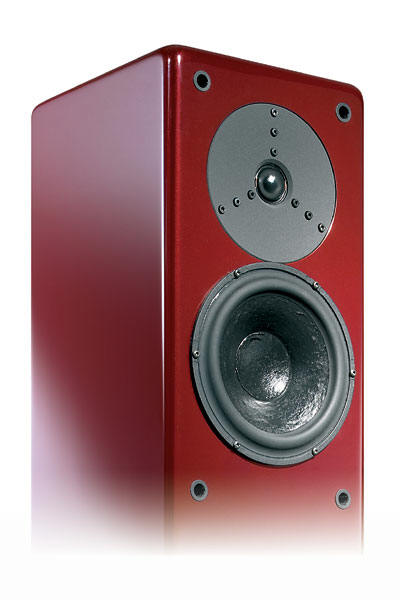
You are reading the older HTML site
Positive Feedback ISSUE
41january/february 2009
merlin
VSM-MXe loudspeakers
as reviewed by Roger S. Gordon

|
Since the early 1990s I have been visiting the Merlin room at the Las Vegas Consumer Electronics Show and more recently at the Denver Rocky Mountain Audio Fest. During my many visits I have always been impressed with the sound. While there were a few years in the early 2000s where I found the sound a tad too analytical for my taste, the Merlin room has always been musical. As I made the rounds of the various rooms at the shows the Merlin room was one of the two or three rooms that I kept coming back to. After being in room after room of amusical and/or bad sound I just had to get back to a room where I could relax and hear real music.
Over the years as I sat listening to my own CDs in the Merlin room I kept wondering if these speakers would sound as good in my own listening room with my own equipment as they did there at the show. When offered the opportunity to review the latest version Merlin's top-of-the-line speaker, I didn't hesitate to say yes. The speakers that were shipped to me in November where the very same pair of speakers that I had heard a month before at the Rocky Mountain Audio Fest.
The speakers arrived in one big, heavy carton. Uncrating the speakers and getting them set up in my listening room was very straight forward. The hardest part was lifting the outer carton up and over the top of the speakers being very careful not to scratch the beautiful piano gloss finish. Having two people on hand to do this task makes it much easier. Once uncrated, moving the speakers into position is not difficult as the speakers are relatively small (43"h x 8.6"w x 10.5"d) and weigh only 85lbs each. The port in the middle of the front face makes a convenient hand hold while moving the speakers. The speakers come with detailed set up instructions plus a small bubble level to be used in making sure the speakers are level. Since the speakers have adjustable spiked feet, getting the speakers level is real easy. The instructions say to move the speakers about 1/3rd of the room length away from the front wall with the speakers six to seven feet apart (center to center) and about nine to eleven feet away from the listening position. Each speaker needs to be toed-in 10 degrees. A wooden jig is provided that makes getting this exact toe-in very quick and easy.
Once the speakers were in position, the last thing to do was to hook up the bass augmentation module (BAM) which in this case was the battery operated Super-BAM. The BAM is an analog device that is inserted into the signal chain either through a tape loop, between the preamp and amp(s), or between the source and the preamp. The BAM provides 5.2dB of bass boost centered around 35Hz. This extends the bass of the VSM-MXe to -4dB at 30Hz. The BAM also includes two filters. One is a high frequency filter that removes noise above 200kHz. The other is a subsonic filter at 28Hz that prevents low frequency signals from getting to the amps(s) and speakers. This is very helpful for low powered tube amps, which in many cases have a hard time dealing with rumble. It also allows the VSM-XMe woofer to reproduce the music without having extraneous low frequency noise mudding up the sound.
In addition to the speakers and the Super-BAM, Bobby Palkovic, the owner and chief designer of Merlin Audio, had Cardas Audio send to me an eight foot pair of Cardas Golden Reference speaker cable and two 2 meter pairs of Golden Reference interconnects for use in connecting the Super-BAM to my system. Bobby uses Cardas Audio cables at the audio shows since he finds these cables to be both neutral and synergistic with his speakers and the Joule Electra electronics that he uses.
With everything connected I played some pink
noise and measured the frequency response at the listening spot with a
1/3rd octave frequency analyzer. The measured response was amazingly
flat. There was a steep drop-off at 30Hz as one would expect due to the
subsonic filter in the Super-BAM. There was also a gentle roll-off at
the extreme top which is what one expects from speakers designed for
home listening as opposed to speakers designed for studio monitoring. Of course, a flat frequency response does not always indicate that a
speaker can play music. So how would the VSM-MXes do on music?
response at the listening spot with a
1/3rd octave frequency analyzer. The measured response was amazingly
flat. There was a steep drop-off at 30Hz as one would expect due to the
subsonic filter in the Super-BAM. There was also a gentle roll-off at
the extreme top which is what one expects from speakers designed for
home listening as opposed to speakers designed for studio monitoring. Of course, a flat frequency response does not always indicate that a
speaker can play music. So how would the VSM-MXes do on music?
The first music CD I popped into the CD player was one that I had played in the Merlin room at several shows: Moussorgsky's Pictures at an Exhibition transcribed for and played on organ by Jean Guillou (Dorian DOR-90117). In the Merlin room at the shows this recording had reproduced an immense hall with each bank of pipes clearly delineated in three dimensional space. The sound was quite spectacular. In my room, with the speakers and the cables fresh out of the box, the music was similar to what that recording had sounded like at the shows. The music was smooth, refined and had wonderful detail. The immense hall and the 3-D imaging were missing however. I was very encouraged though. If the speakers sounded this good now, how would they sound after they and the cables had a chance to settle and burn-in? For the next week, I did not do any critical listening, I just played CD after CD.
After the burn-in I played the Moussorgsky again. The sound stage was wider and deeper and the imaging was more precise, but still not what I had heard at the shows. Now it was time to start the fine tuning. Over the next several weeks I moved the speakers and my listening position many times varying the distance of the speakers from the front wall, varying the distance between the two speakers, and varying the distance of the speakers to my listening position. All of the changes made a difference to the sound, though many of the changes were not improvements. Over time I gradually got closer and closer to the optimum position. Once I had reached what I felt was the optimum positions for the speakers and the listening position I replayed the Moussorgsky. The sound stage was bigger. Imaging was more three dimensional, but it still was not that spectacular sound that I remembered from the shows.
After discussing the situation with Bobby Palkovic he suggested it was time to try removing the Super-BAM from the tape loop and trying it in the other two positions. Wow. What an improvement. With the Super-BAM between the preamp and amps and also between the CD player and the preamp the soundstage and imaging on the Moussorgsky CD really improved. While the sound between the two positions was very similar I ultimately preferred the Super-BAM between the CD player and the preamp as the bass was slightly fuller in that location.
With the Super-Bam in its new location the Moussorgsky CD now sounded very close to the sound that I heard at the shows. Due to differences in room and equipment, the sound would never be the same. However, it was close enough that it was time to stop fiddling with the equipment and just listen to the music. Over the next week I played all sorts of music: orchestral, chamber, choral, female vocalists, male vocalists, soundtracks, classic rock (Def Leppard), current rock (Rammstein, The Pillows) and worldbeat/jazz (Yoko Kanno). Regardless of the music genre, the VSM-MXes played music.
The one thing I had been concerned about when I agreed to review the VSM-MXEs was a possible mismatch between the speakers and my 24 watt per channel single ended triode deHavilland amps. SET amps are not known for their ability to deliver thunderous lowest octave bass. When using my own VMPS RM30C speakers in my system I roll off the amps at 100Hz with a capacitor and use a 15" subwoofer to fill in the bass. I was worried that hooked up to the VSM-MXes my amps could not deliver forceful bass down to 30Hz. Or even worse, with the BAM providing a 5.2dB boost in the bass the deHavillands might become overloaded and start clipping. Neither of these events occurred. At no time, with all of the different types of music that I played, did I find the VSM-MXe/deHavilland combination to be bass shy. For fun though, I did swap the deHavilland amps out for a pair of updated Eagle 400 mono blocks (350 watt per channel solid state). The Eagle 400 is a legendary John Iverson design. The 400s have been criticized as not having a top end to match their superb midrange and incredible bottom end. However, if you are playing hard rock, who the heck cares about the top end. Playing Rammstein on the VSM-MXes with the Eagle 400s at 105dB is head-banging pleasure. With some loudspeakers as the volume increases the sound turns harsh or brittle. Not with the VSM-MXes. As I cranked the volume up to as loud as I could stand, I did not notice any change in the quality of the sound.

As much as I liked the Heavy Metal/Hard Rock/Eagle 400/VSM-MXe combination, the deHavilland/VSM-MXe combination is, to my ears, the better combination. The reason why people own single ended triode amps is that they are seduced by the glorious midrange and the delicate and spacious top end. The VSM-MXes allow the sound of the deHavillands to come through virtually unaltered. Therefore, out came the Eagle 400s and back into the system went the deHavillands.
With the deHavillands back in the system I played the famous Decca recording of Holst's The Planets with Mehta and the LA Philharmonic on a JVC xrcd24 reissue (JVCXR-0228-2). I had heard The Planets performed two weeks early at the San Diego Symphony and it was interesting to contrast my aural memory of the live performance with what I was hearing through the VSM-MXes. The live and the recorded performances are obviously different as are the listening perspectives. My seat is in the mezzanine not six rows back from front row center as in the recording. Yet as I closed my eyes and listened to the recording it was very much like my experience in the concert hall. I was following individual lines of melody; listening for the entrance of certain instruments. I became caught up and swept up away by the emotion of the music just as I had been in the concert hall. As the final strains of the last movement, Neptune, the Mystic, faded away I felt just as happy and emotionally satisfied as I had at the end of the live concert. The xrcd recording is a spectacular job of mastering and production. It is so good that I have stopped playing my original London LPs (CS-6734) of the recording and play the xrcd exclusively. Yet as good as the xrcd is, it is still not close to the sound of a live performance. But if the playback of a recording can satisfy your emotional need for music, does it really matter if the played back sound is less than the live sound?
After playing The Planets I next played the 96/24 re-mastered reissue of the 1974 Decca recording of Beethoven's Violin Sonata No. 9, the “Kreutzer” with Perlman and Ashkenazy (Decca 475 7509). With my eyes closed Perlman was playing his violin fifteen feet in front of me with Ashkenazy's piano right behind him. I am usually not a big fan of chamber music. However, I sat through the entire 37 minutes of the sonata mesmerized by the music; hearing the roller coaster of emotions—the rage, the pain, and the despair of Beethoven over the loss of his hearing.
Following the Beethoven I played the Barber Violin Concerto, Hugh Wolff conducting the St. Paul Chamber Orchestra with Hilary Hahn, violinist (Sony SK89029) Hahn is closely mic'd with the orchestra spread out across a wide soundstage behind Hahn.. The violin sounds real. The emotion, the excitement of this very fast, very passionate performance comes through as once again, I get swept away with the blazing violin at the finale.
The descriptions of the above three CDs, unlike normal reviews, does not describe the sound of these CDs played through the VSM-MXe speakers. That is because discussing sounds as played back through the VSM-MXes misses the point. The VSM-MXes are designed to play back music. They are designed to convey the emotional content of music not just the sound. Yes, the VSM-MXes are very detailed, very neutral with a flat frequency response. They are remarkably transparent. They sound very smooth and refined. Thus, VSM-MXes would make an excellent analytical tool to hear what is happening upstream in the signal path. However, the analytical tool market is not the niche that the VSM-MXes are designed for. The VSM-MXes are aimed at music lovers with small to medium size listening rooms (5,000 cubic feet max) who want to hear their recordings produced as accurately as possible so that they can connect to the music.
Now one of my friends who came over to listen to the VSM-MXes commented that because the VSM-MXes are a small two way speaker with only a 6.5" driver handling the bass that there is no way the VSM-MXes could possibly created lifelike concert hall bass. My friend did agree that the bass the VSM-MXes produce is remarkably accurate. The speakers produce the right tone and timbre for the bass notes and the sharp transients on percussion instruments start and stop on a dime. However, a 6.5" driver just can't move the same volume of air as a 15" subwoofer. Thus, the VSM-MXes can not produce the pressure waves that are required for a lifelike experience. I admit that I do like listening to Telarc recordings with the 'Big Drum'. When the 'Big Drum' is struck it is fun to feel the pressure wave generated by my 15" subwoofer hitting my chest. However, is that pressure wave really accurate? Last night I attended another concert at San Diego Symphony Hall and heard Mahler's Symphony No. 6. The 6th is played with a very large orchestra including seven percussionists. Two of the percussionists play timpani and another had full-time duty on the bass drum. With all of the mighty whacks on the drums I never felt a pressure wave hit my chest. When the Hammerstroke of Fate (1) crashed down, it was the loudest sound that I had ever heard in a symphony hall. But even with the Hammerstroke of Fate there was no pressure wave hitting my chest. Perhaps if I had been sitting in the front row I would have felt a pressure wave. However, in comparing what I heard and felt from my seat in the mezzanine to what I hear reproduced in my listening room via the 6" drivers of the VSM-MXes, the VSM-MXes do a wonderful job of producing concert hall bass.
So to summarize my experience with the VSM-MXes, they are remarkable speakers - detailed, transparent, and neutral. They allow the music to flow from any type of music. For the set-and-forget type of person, the VSM-MXes will produce music right out of the box. However, if you spend the time to properly set-up the speakers and the BAM you will be amply rewarded. On the best recordings the three dimensional imaging can be stunning. On less than the best recordings you will be able to hear all of the music and the emotional content that has been captured on the recording. Be forewarned. If you are a true audiophile and use your audio system to listen to sounds, not music, you probably won't be able to fully appreciate the capabilities of the VSM-MXes. On the other hand, if you listen to music because music touches your soul, you really should find a way to listen to your favorite recordings through the VSM-MXes in a properly set up system. You will be very happy you did. Highly recommended. Roger S. Gordon
Merlin VSM-MXe loudspeakers
Retail: $11,500 per
pair with Super-BAM
Merlin Music Systems, Inc.
www.merlinmusic.com
(1) The Hammerstroke of Fate is a sound effect that is unique to Mahler's 6th Symphony. Mahler described it as a loud non-metallic sound like a axe felling a large tree with one stroke. Each orchestra has to decide how to create this sound. For this performance the percussionists created a large wooden structure 5' x 5' x 8' which acted as the drum. A mallet was also constructed with a 24" x 12" x 4" wooden head attached to a six foot pole. At the appointed times the percussionist, positioned above and behind the box, brought the mallet smashing down on top of the wooden box. The sound was similar to a large stack of 4' x 8' plywood sheets crashing to a cement floor from a height of 30 feet.

